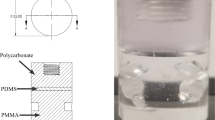Abstract
The nucleation of internal cavities and their transition to cracks are examined at high spatial and temporal resolutions within polydimethylsiloxane (PDMS) elastomers of various cross-link densities under externally applied quasi-static mechanical loads. The focus here is on experiments where the initiation and propagation of internal damage are designed to occur in between two spherical glass beads that are firmly embedded within a matrix of the PDMS elastomer and are placed close to each other in order to generate a high triaxial stress state. An optical microscope is used to monitor the various processes of nucleation and growth of cavities and cracks at a spatial resolution of about \(1\,\upmu \hbox {m}\) and a temporal resolution of about 66.7 ms. In combination with corresponding full-field simulations, the experiments show that the nucleation of cavities—that is, the onset of cavitation—is an extremely fast process (involving stretch rates in excess of \(100\,\hbox {s}^{-1})\) that is controlled primarily by the stiffening at large deformations of the underlying elastomer and, more critically, by its fracture properties. The experiments and simulations also show that cavitation is followed by two distinct events upon further macroscopic loading: the transition of the nucleated cavities to micro-cracks, and the further transition of some micro-cracks to macro-cracks. These two distinct events are also controlled primarily by the fracture properties of the underlying elastomer.
















Similar content being viewed by others
Notes
The experimental approach of high spatiotemporal resolution presented here can equally be applied to investigate cavitation in rubber confined between other geometries (not just spherical beads). Indeed, akin to the work of Cho et al. (1987), we have employed the same approach introduced here to study cavitation within a PDMS elastomer confined between two cylindrical fibers. The analysis of these experiments will be presented elsewhere.
We recall that the criterion (3) can be thought of (see Section 5 in Lopez-Pamies et al. 2011a) as a generalization of the classical elastic cavitation criterion of Gent and Lindley (1959a, b) for the case when: (1) the rubber contains a random isotropic distribution of vacuous defects (as opposed to just a single spherical vacuous defect) and (2) the rubber is subjected to arbitrary loading (as opposed to just purely hydrostatic loading).
References
Ball JM (1982) Discontinuous equilibrium solutions and cavitation in nonlinear elasticity. Philos Trans R Soc Lond 306:557–610
Cho K, Gent AN, Lam PS (1987) Internal fracture in an elastomer containing a rigid inclusion. J Mater Sci 22:2899–2905
Cristiano A, Marcellan A, Long R, Hui CY, Stolk J, Creton C (2010) An experimental investigation of fracture by cavitation of model elastomeric networks. J Polym Sci Part B Polym Phys 48:1409–1422
Gent AN (1991) Cavitation in rubber: a cautionary tale. Rubber Chem Technol 63:G49–G53
Gent AN, Lindley PB (1959a) Internal flaws in bonded cylinders of soft vulcanized rubber subjected to tensile loads. Nature 180:912–913
Gent AN, Lindley PB (1959b) Internal rupture of bonded rubber cylinders in tension. Proc R Soc A2:195–205
Gent AN, Park S (1984) Failure processes in elastomers at or near a rigid spherical inclusion. J Mater Sci 19:1947–1956
Gent AN, Wang C (1991) Fracture mechanics and cavitation in rubber-like solids. J Mater Sci 26:3392–3395
Green AE, Zerna W (1954) Theoretical elasticity. Oxford University Press, London
Griffith AA (1921) The phenomena of rupture and flow in solids. Philos Trans R Soc Lond A 221:163–198
Hou H-S, Abeyaratne R (1992) Cavitation in elastic and elastic–plastic solids. J Mech Phys Solids 40:571–592
Kabaria H, Lew AJ, Cockburn B (2015) A hybridizable discontinuous Galerkin formulation for non-linear elasticity. Comput Methods Appl Mech Eng 283:303–329
Kumar A, Aranda-Iglesias D, Lopez-Pamies O (2016) Some remarks on the effects of inertia and viscous dissipation in the onset of cavitation in rubber. J Elast. doi:10.1007/s10659-016-9589-y
Lefèvre V, Ravi-Chandar K, Lopez-Pamies O (2015) Cavitation in rubber: an elastic instability or a fracture phenomenon? Int J Fract 192:1–23
Lian Y, Li Z (2012) Position and size effects on voids growth in nonlinear elasticity. Int J Fract 173:147–161
Lopez-Pamies O (2009) Onset of cavitation in compressible, isotropic, hyperelastic solids. J Elast 94:115–145
Lopez-Pamies O (2010) A new \(I_{1}\)-based hyperelastic model for rubber elastic materials. C R Mec 338:3–11
Lopez-Pamies O, Idiart MI, Nakamura T (2011a) Cavitation in elastomeric solids: I—a defect-growth theory. J Mech Phys Solids 59:1464–1487
Lopez-Pamies O, Nakamura T, Idiart MI (2011b) Cavitation in elastomeric solids: II—onset-of-cavitation surfaces for neo-Hookean materials. J Mech Phys Solids 59:1488–1505
Nakamura T, Lopez-Pamies O (2012) A finite element approach to study cavitation instabilities in nonlinear elastic solids under general loading conditions. Int J Non Linear Mech 47:331–340
Oberth AE, Bruenner RS (1965) Tear phenomena around solid inclusions in castable elastomers. Trans Soc Rheol 9:165–185
Stringfellow R, Abeyaratne R (1989) Cavitation in an elastomer: comparison of theory with experiment. Mater Sci Eng A 112:127–131
Williams ML, Schapery RA (1965) Spherical flaw instability in hydrostatic tension. Int J Fract Mech 1:64–71
Xu X, Henao D (2011) An efficient numerical method for cavitation in nonlinear elasticity. Math Models Methods Appl Sci 21:1733–1760
Acknowledgements
This work was performed during the course of a collaborative investigation into cavitation, fracture and damage in soft materials funded by the National Science Foundation Grants CMMI-1235352 and CMMI-1235138. This support is gratefully acknowledged.
Author information
Authors and Affiliations
Corresponding author
Electronic supplementary material
Below is the link to the electronic supplementary material.
Supplementary material 1 (avi 28783 KB)
Supplementary material 2 (avi 16265 KB)
Rights and permissions
About this article
Cite this article
Poulain, X., Lefèvre, V., Lopez-Pamies, O. et al. Damage in elastomers: nucleation and growth of cavities, micro-cracks, and macro-cracks. Int J Fract 205, 1–21 (2017). https://doi.org/10.1007/s10704-016-0176-9
Received:
Accepted:
Published:
Issue Date:
DOI: https://doi.org/10.1007/s10704-016-0176-9




